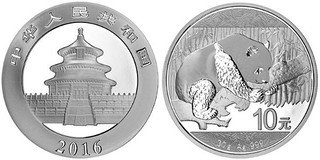
PREV ARTICLE
NEXT ARTICLE
FULL ISSUE
PREV FULL ISSUE
CHINESE GOVERNMENT CUTS SILVER IN PANDA COINSDrage Vukcevich writes: The Chinese Government is lowering the amount of silver in their silver Panda coins, from 31.1 grams (1 troy ounce) to only 30 grams. The claim is that this is being done for Asian collectors, who look more at gram weights than troy weights. I say, B*LLSH*T! Just another stinking Communist LIE. All they want to do is cheat people out of silver.
Drage's note was the first I'd heard of this, and coming following news of the downturn in the Chinese economy, is in line with
historical debasements that have taken place since ancient times whenever a government wants to squeeze some more juice out of the same
old lemons. But the situation may be more nuanced, even if the timing is convenient for the Chinese. Here's a Numismatic News
article on the topic by Pat Heller, published December 17, 2015. -Editor
The usage of troy ounce weights traces its history back to the ancient Roman monetary system. At one point in Roman history, bronze bars were used as currency. The aes grave (meaning heavy bronze) weighed one pound. The unit called uncia, which became ounce in the English language, was defined as one-twelfth the weight of the aes grave. The troy ounce weighs 31.1034768 grams (usually rounded to 31.1 grams) or 480 grains or 20 pennyweights. In contrast, the avoirdupois ounce used to weigh bananas and humans weighs 28.349523125 grams (usually rounded to 28.35 grams), 437.5 grains, or 18.229 pennyweights. A troy ounce is about 10 percent heavier than the avoirdupois version. To be precise, the troy ounce is 192/175 times the weight of the other ounce. In the London Bullion Market and on commodity exchanges in the United States, precious metals contracts are specified in a certain number of troy ounces. On the New York COMEX, for instance, a gold contract is for 100 troy ounces, a silver contract is 5,000 troy ounces, platinum is 50 troy ounces, and palladium is 100 troy ounces. Two events, one that just happened and one coming in April 2016, may end up with the use of troy ounce measurements in precious metals becoming obsolete. With the recent release of the 2016-dated Chinese Pandas, the sizes are no longer stated in troy ounce measurements. Instead, the coins that used to weigh one troy ounce now weigh 30 grams, slightly less than prior year issues. Smaller-sized coins are also proportionately smaller. To help minimize confusion, the new coins list their precious metal content in grams. This change was announced about a year ago. In the Far East, metric measurements are the standard, so the new coins make them more practical for trading in that part of the world. The Shanghai Gold Exchange is planning to begin trading 1 kilogram (1,000 grams or about 32.15 troy ounces) gold contracts in April 2016. Once again, the weight standard matches what is commonly used in the Far East. There are two features to these forthcoming SGE contracts that have a good chance of shifting the world’s dominant precious metals markets from the West and also away from the U.S. dollar. First, the SGE contracts will be fulfilled by immediate delivery of the physical metal instead of merely being the exchange of paper assets. Almost certainly, some percentage of the world’s gold investors would prefer 100 percent certainty of owning gold versus merely holding a piece of paper. Second, the SGE contracts will be priced in Chinese yuan and payment can only be made using that currency. If you think that the close timing of these two events that push for metric weights of precious metals instead of the troy ounce measurements means they are related, it is not out of the question. The Chinese government has been aggressively signing bilateral agreements with governments across the globe to displace the use of U.S. dollars in international transactions and payments, using instead the currencies of the signatory nations. If not deliberately timed to coincide with each other, the modification of Panda weights and the forthcoming trading of Shanghai Gold Exchange contracts both using metric standards is consistent with other actions of the Chinese government. Since the world’s largest gold consuming nations, China and India, use metric weights for governmental and private precious metals trading, it is highly likely that people in many other Far East nations will also adopt metric units and the Chinese yuan as benchmarks for measuring precious metals transactions. Considering this information, I would not be at all surprised to see the usage of troy ounce weights for precious metals disappear within the next decade or two. To read the complete article, see:

Wayne Homren, Editor The Numismatic Bibliomania Society is a non-profit organization promoting numismatic literature. See our web site at coinbooks.org. To submit items for publication in The E-Sylum, write to the Editor at this address: whomren@gmail.com To subscribe go to: https://my.binhost.com/lists/listinfo/esylum All Rights Reserved. NBS Home Page Contact the NBS webmaster 
|
